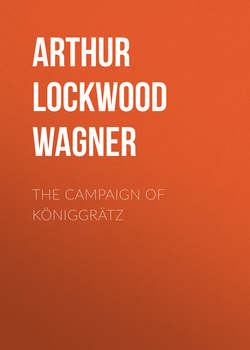Читать книгу The Campaign of Königgrätz - Arthur Lockwood Wagner - Страница 8
THE CAMPAIGN OF KÖNIGGRÄTZ
THE INVASION OF BOHEMIA
ОглавлениеIt was now certain that Bohemia was to be the theater of war. This province of the Austrian Empire may be described as a huge basin, whose rim is composed of mountains. It is separated from Silesia by the Riesengebirge (Giant Mountains), from Saxony by the Erzgebirge (Iron Mountains), from Moravia by the Moravian Hills, and from Bavaria by the Fichtelgebirge and the Böhmerwald; the Moravian Hills and the Böhmerwald separating it from the valley of the Danube. This great basin is drained by the Elbe river, which, rising in the Riesengebirge, makes a huge loop, flowing first south, then west, and finally north, and receives the waters of the Iser, Adler, Moldau and Eger rivers before it issues forth from the Bohemian frontier into Saxony. This theater is well suited to defensive operations, as the mountain frontiers are penetrated by few passes, and the forests and rivers constitute additional obstacles. On the Silesian frontier the only issues by which an invader can enter Bohemia are the passes of Trautenau, Eypel, Kosteletz, Nachod and Neustadt. These passes could all be easily defended, while on the Saxon frontier the passes of Reichenberg, Gabel and Königstein-Tetschen could be used by retarding forces, which could afterwards find a strong defensive line on the Iser.
No. 2.
1st. ARMY ON 22ND., 23RD. & 24TH. JUNE.
Two railway lines lay in the theater of war, and were of great importance to the contending armies. One line ran from Vienna, via Kosel, Breslau and Görlitz, to Dresden. The other connected the Austrian capital with Prague, via Olmütz (or Brünn) and Bömisch Trübau. The two lines were joined by a railway from Dresden to Prague, and by one which, running from Löbau to Turnau, branched from the latter point to Prague and Pardubitz. These railways connected with others leading to all the important cities of Prussia. The two Prussian armies could cover their railway communications while advancing; but the Prague-Olmütz line, which was of vital importance to the Austrian army, ran parallel to, and dangerously near, the Silesian frontier, and was not covered by the Austrian front during the operations in Bohemia.
The Prussian advance began on the 20th of June. The Army of the Elbe marched from the vicinity of Dresden, via Stolpen, Neustadt, Schluckenau and Rumburg, to Gabel. As the greater part of this march had to be made by one road, it required six days, though the distance was only 65 miles. The First Army had concentrated at Zittau, Herrnhut, Hirschfelde, Seidenberg and Marklissa. From these points it began its march on the 22d of June, each division marching by a separate road; and on the 25th it was closely concentrated around Reichenberg. The entire Prussian front was now reduced to about 100 miles, and Herwarth Von Bittenfeld was only twelve miles from Frederick Charles.
It would have been dangerous in the extreme for the Crown Prince to begin his march while Von Benedek held six corps in hand to hurl upon him. The passage of the Second Army through the defiles depended on surprise; and in the face of a superior and concentrated army, it would have been a desperate undertaking. It was necessary, therefore, to distract the plans of the enemy by false maneuvers, and to wait for Frederick Charles to menace the Austrian left, on the Iser, before beginning the forward movement with the Second Army. With these objects in view, the VIth Corps was ordered to push forward towards Olmütz, and Frederick Charles received the following instructions from Von Moltke: “Since the difficult task of debouching from the mountains falls upon the Second, weaker, Army, so, as soon as the junction with Herwarth’s corps is effected, the First Army must, by its rapid advance, shorten the crisis.” The VIth Corps moved from Neisse into the Austrian dominions as far as Freiwaldau, where its advanced-guard had a successful skirmish with a party of Austrian cavalry. This corps was supposed by the Austrians to be the advanced-guard of the Crown Prince’s army marching upon Olmütz; and the demonstration had the effect of holding a large force of Austrians between Hohenmauth and Bömisch Trübau, where it could not be used to oppose the real advance of the Second Army.
The Crown Prince’s army was to move as follows:
The Ist Corps3 via Liebau and Trautenau, to Arnau;
The Guards, via Neurode, Braunau, Eypel, to Königinhof;
The Vth Corps, via Glatz, Reinerz, Nachod, to Gradlitz;
The cavalry, from Waldenburg, via Trautenau, to Königinhof.
No. 1.
PROPOSED ADVANCE OF 2ND. ARMY FROM 25TH. TO 28TH. JUNE.
No. 3.
POSITION OF BOTH ARMIES ON THE EVENING OF THE 25TH. JUNE.
The VIth Corps, having made the diversion to Freiwaldau, was withdrawn to Glatz and Patschkau, from which points it was to follow the Vth. A corps of observation, consisting of two regiments of infantry, one of cavalry, and a light battery, was detached at Ratibor to make demonstrations against Austrian Silesia. In case this detachment should encounter a large force of the enemy, it was to fall back upon the fortress of Kosel. During the campaign an unimportant war of detachments was carried on in this region, generally to the advantage of the Prussians.
3
It may be of assistance to the reader, in the following pages, to note that the divisions in the Prussian army are numbered consecutively throughout the several army corps. Thus, the Ist Corps consists of the 1st and 2d Divisions; the IId Corps, of the 3d and 4th Divisions; the VIth Corps, of the 11th and 12th Divisions, and so on.
